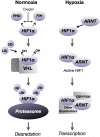Hypoxia and hypoxia inducible factors: diverse roles in liver diseases
- PMID: 22120903
- PMCID: PMC3417333
- DOI: 10.1002/hep.25497
Hypoxia and hypoxia inducible factors: diverse roles in liver diseases
Abstract
Hypoxia has been shown to have a role in the pathogenesis of several forms of liver disease. The hypoxia inducible factors (HIFs) are a family of evolutionarily conserved transcriptional regulators that affect a homeostatic response to low oxygen tension and have been identified as key mediators of angiogenesis, inflammation, and metabolism. In this review we summarize the evidence for a role of HIFs across a range of hepatic pathophysiology. We describe regulation of the HIFs and review investigations that demonstrate a role for HIFs in the development of liver fibrosis, activation of innate immune pathways, hepatocellular carcinoma, as well as other liver diseases in both human disease as well as murine models.
Copyright © 2011 American Association for the Study of Liver Diseases.
Figures


Similar articles
-
Hypoxia and fatty liver.World J Gastroenterol. 2014 Nov 7;20(41):15087-97. doi: 10.3748/wjg.v20.i41.15087. World J Gastroenterol. 2014. PMID: 25386057 Free PMC article. Review.
-
Oxygen: modulator of physiological and pathophysiological processes in the liver.Z Gastroenterol. 2006 Jan;44(1):67-76. doi: 10.1055/s-2005-858987. Z Gastroenterol. 2006. PMID: 16397842 Review.
-
Hypoxia inducible factors regulate hepatitis B virus replication by activating the basal core promoter.J Hepatol. 2021 Jul;75(1):64-73. doi: 10.1016/j.jhep.2020.12.034. Epub 2021 Jan 29. J Hepatol. 2021. PMID: 33516779 Free PMC article.
-
Hypoxia inducible factors in liver disease and hepatocellular carcinoma: current understanding and future directions.J Hepatol. 2014 Dec;61(6):1397-406. doi: 10.1016/j.jhep.2014.08.025. Epub 2014 Aug 23. J Hepatol. 2014. PMID: 25157983 Review.
-
Hypoxia-Inducible Factors and the Regulation of Lipid Metabolism.Cells. 2019 Mar 3;8(3):214. doi: 10.3390/cells8030214. Cells. 2019. PMID: 30832409 Free PMC article. Review.
Cited by
-
High-Mobility Group Box 1 Promotes Hepatocellular Carcinoma Progression through miR-21-Mediated Matrix Metalloproteinase Activity.Cancer Res. 2015 Apr 15;75(8):1645-56. doi: 10.1158/0008-5472.CAN-14-2147. Epub 2015 Feb 26. Cancer Res. 2015. PMID: 25720799 Free PMC article.
-
Nanodrug rescues liver fibrosis via synergistic therapy with H2O2 depletion and Saikosaponin b1 sustained release.Commun Biol. 2023 Feb 16;6(1):184. doi: 10.1038/s42003-023-04473-2. Commun Biol. 2023. PMID: 36797395 Free PMC article.
-
Hypoxia Affects HIF-1/LDH-A Signaling Pathway by Methylation Modification and Transcriptional Regulation in Japanese Flounder (Paralichthys olivaceus).Biology (Basel). 2022 Aug 18;11(8):1233. doi: 10.3390/biology11081233. Biology (Basel). 2022. PMID: 36009861 Free PMC article.
-
Sodium pentobarbital dosages for exsanguination affect biochemical, molecular and histological measurements in rats.Sci Rep. 2020 Jan 15;10(1):378. doi: 10.1038/s41598-019-57252-7. Sci Rep. 2020. PMID: 31942001 Free PMC article.
-
Profiles of messenger RNAs and MicroRNAs in hypoxia-induced hepatic stellate cells.Ann Transl Med. 2021 Sep;9(18):1451. doi: 10.21037/atm-21-4215. Ann Transl Med. 2021. PMID: 34734003 Free PMC article.
References
-
- Jungermann K, Kietzmann T. Oxygen: modulator of metabolic zonation and disease of the liver. Hepatology (Baltimore, Md.) 2000;31:255–260. - PubMed
-
- Jaakkola P, Mole DR, Tian YM, Wilson MI, Gielbert J, Gaskell SJ, Kriegsheim A, et al. Targeting of HIF-alpha to the von Hippel-Lindau ubiquitylation complex by O2-regulated prolyl hydroxylation. Science. 2001;292:468–472. - PubMed
-
- Dimova EY, Kietzmann T. Hypoxia-inducible factors: post-translational crosstalk of signaling pathways. Methods Mol Biol. 647:215–236. - PubMed
Publication types
MeSH terms
Substances
Grants and funding
LinkOut - more resources
Full Text Sources
Other Literature Sources
Medical
